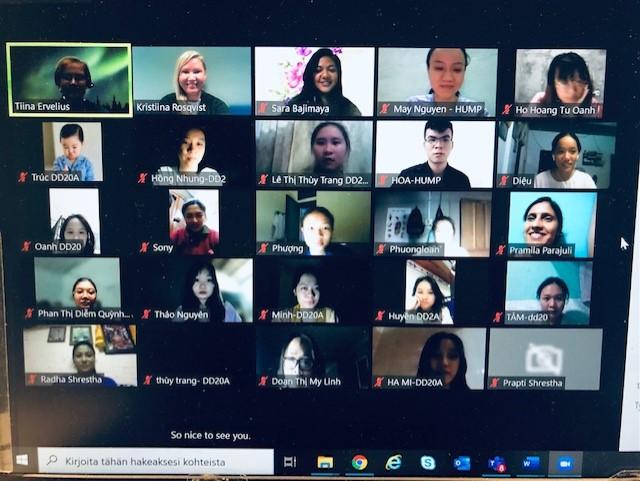Video-based simulations as a learning method

Simulations as a pedagogical approach is known as an efficient learning method for students. It is a student-centred way to learn nursing skills, interaction, and teamwork in a patient-safe environment.
Diaconia University of Applied Sciences (Diak) has a long history of implementing simulation learning in classroom settings. During the Covid-19 pandemic period, the development of remote simulations has also increased in Diak, allowing many students to participate physically around the country and even around the world.
During the DVINE project we have used different kinds of simulations, e.g. simulations in classroom settings in Vietnam and Nepal in 2019 and remote simulations between 2020 and 2021.
Remote simulations have been implemented in various ways. Partly due to the Covid-19 pandemic, we have had to think of various solutions. One of these was video-based remote simulations, which was a new experiment for Diak. The co-development of learning methods was seen as important.
Briefing of the simulation
The learning sessions were prepared following the simulation pedagogical protocol. Students attended via Zoom from Vietnam and Nepal.
The learning sessions started by going through the simulation pedagogical protocol and discussing patient safety tools needed in nursing situations e.g. the ABCDE approach, NEWS and the ISBAR reporting tool.
We also discussed communication and encountering the patient and family members in different cultures. The video-based simulation began by dividing the observer’s tasks among the students. We had prepared various tasks for each video. This was the briefing part of the simulation learning situation.
Students participated by making videos for simulation
The second part consisted of the implementation of the video-based simulation. Videos concerning various nursing situations were prepared by Diak’s nursing students, who did their thesis work in this project.
The videos used in these learning sessions concerned study units 1 and 4. The videos addressed these topics:
1) Nurses examining of the patient;
2) Transferring the patient;
3) Communication with the family members; and
4) Communication between nurses and the patient.
You can find four videos in the DVINE project’s YouTube playlist. In the simulations, the videos were presented one at time. The students followed the videos via Zoom.
Three stages of learning discussion
The third part of the learning session was a learning discussion. We discussed the nursing situation after each of the videos. The students had made their own notes while watching the video, and the discussion progressed through three stages: description; analysis; and application.
In the description stage, the students described what they had seen in the nursing situation, and what it concerned. In the analysis stage, the discussion went more deeply into the nursing situation and the phenomenon in question. The application stage prepared students to face similar situations in the future, e.g. in clinical practices.
The overall feedback was encouraging, and the students appreciated the student-centred way of learning. Simulation brings real-life situations a little closer and helps students prepare for clinical practices.
These video-based simulations included the great topic of “encountering” in various situations among patients, family members and nurses. The students felt they had received good advice for how to meet patients and family members in times of need in the future.
Video-based simulation was also a new way to teach and learn for us as teachers, and we found it a good learning experience.
Text: Kristiina Rosqvist & Tiina Ervelius
